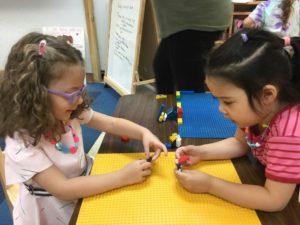IPS is currently closed for summer vacation. Please enjoy an encore post on a timely back-to-school topic!

Separation anxiety (and the separation process) can be one of the most difficult times of the year for children and parents alike! At The International Preschools, we take separation seriously and strive to provide the most productive and nurturing route for our students. Click below for a blog post on separation anxiety and how to deal with it, which I run every year in September. Happy first days of school!
The children’s book, Wemberly Worried by Kevin Henkes, tells the story of a child named Wemberly who worries about everything. Her biggest worry of all? The first day of school! Ultimately, Wemberly vows not to worry so much in the future, so that she won’t miss out on the fun.
 Like , separation anxiety is a natural thing for children (and parents) to feel during the first days of school. Some children transition easily into school right away, saying goodbye to their parents without ever turning back. Others might start on day one, excited and enthusiastic, and return on day two hesitantly and apprehensively; this often occurs when a child realizes that school doesn’t occur just one day a year! And still, other children take days or weeks to warm up to their new school environment. Rest assured, this behavior is to be expected, and the teachers and staff at The International Preschools are ready to help!
Like , separation anxiety is a natural thing for children (and parents) to feel during the first days of school. Some children transition easily into school right away, saying goodbye to their parents without ever turning back. Others might start on day one, excited and enthusiastic, and return on day two hesitantly and apprehensively; this often occurs when a child realizes that school doesn’t occur just one day a year! And still, other children take days or weeks to warm up to their new school environment. Rest assured, this behavior is to be expected, and the teachers and staff at The International Preschools are ready to help!
In the Red Rooms (2s), the phase-in schedule is a two-month process that requires parent/caregiver participation. This allows for the youngest children at The International Preschools, most of whom have never been to school before, to separate gradually and smoothly from their parents. Children will attend school from 9:00am-10:00am during week 1, from 9:00am-10:30am during week 2, and so forth until the full three-hour school day is reached in mid-October.
In the Green (3s), Pre-K (4s) and Junior K (4s/5s) at The International Preschools, the phase-in schedule lasts only a few days. While parents/caregivers are not expected to stay in the classroom with the children after the first day of school, it is a good idea to be available to stay should the need arise.
When given the opportunity to choose to spend time in the classroom with a beloved parent/caregiver or a teacher that he/she does not know, the answer is obvious: your child will always choose you! There is a tactic that many teachers employ during the phase-in process that helps with creating connections: asking parents to wait in the hallway while the child is inside the classroom. This strategy works for many children; they can bond with his/her teachers and peers, and you can remain nearby in case your child needs you.
Here are some ways to make “arrival time” a smooth one for your child:
- Review the daily schedule with your child. At The International Preschools, each classroom has a schedule posted for the children to “read.” This schedule uses pictures and words to let the children know what will occur during the day. In addition to being a great pre-reading tool (by allowing children to associate pictures with words), the daily schedule provides structure and comfort for the children by letting them know “what comes next.” At the end of every day, there is a “dismissal” picture,” which is used as a visual reference throughout the day for the children. Reminding your child that you (or your spouse/partner, nanny, or other trusted adult) will always come back to pick him/her up gives your child confidence and assurance that you will return.
- Allow your child to choose one thing to show/do with you. Some children might see you entering the classroom as the opportunity to delay your exit by trying to show you everything he/she can think of in the classroom. In other cases, parents may lengthen their stay in fear that their child will become upset when they leave. Allowing your child to choose one activity (or to show you one piece of art, for example) gives him/her a sense of control over decision making. However, you are setting the limits by only permitting one activity. You can preface this event by saying something such as, “Choose one toy to show me, and then I have to go to work/home.”
- When applicable, allow your child to bring a small “transitional object” to school to keep in his/her backpack. This simple action may make the transition out of the house and into the classroom easier for your child…and for you! For some children, the knowledge of having a special item (a book, a stuffed animal, etc.) in his/her backpack is enough to create a comforting home-to-school connection. Many teachers do not allow children to carry toys from home around with them during the day unless needed; it is best to speak to your child’s teacher to see what will work for his/her classroom.
- Always say “goodbye” to your child. Although “sneaking out” when your child is happily engaged in an activity might seem like a good idea, this tactic could cause trouble in the near future. Once your child realizes that you are gone, he/she may become upset, and next time, might have an even harder time separating from you.
Interested in our school? Learn more about the admissions process by clicking here.
